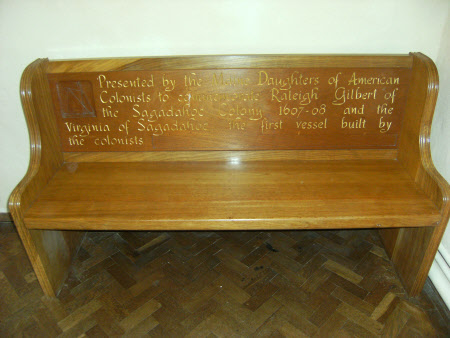Pew
Category
Furniture
Date
Unknown
Materials
Oak
Order this imageCollection
Compton Castle, Devon
NT 224119
Caption
Raleigh Gilbert was the son of Sir Humphrey Gilbert and the half nephew of Sir Walter Raleigh. He was second in command, under George Popham, of an expedition to colonise Maine in 1607. The colony was short-lived, lasting only one year. This was not due to starvation but rather due to the colonists desire to return home. Gilbert also returned to England on receiving news that his brother had died leaving him heir to the title and estate of Compton Castle.
Summary
Oak pew with carved plaque, given to Commander Gilbert by the Maine Daughters of American Colonists to commemorate Raleigh Gilbert's Colony of 1607 in Maine. (Given in 1976). Bequeathed by Commander Gilbert in 1977.
Full description
Carved into the pew is a dedication to Ralegh Gilbert, son of Sir Humphrey Gilbert. The inscription reads ‘Presented by the Maine Daughters of American Colonists to commemorate Raleigh Gilbert of the Sagadahoc Colony 1607-08 and the Virginia of Sagadahoc the first vessel built by the colonists.’ The inscription on the bench draws attention to an event of the 17th century that was later integrated into the 19th century romanticisation of Ralegh, his father Sir Humphrey Gilbert, Gilbert’s half-brother Sir Walter Raleigh and other seafarers and colonists of their time. The bench itself is of mid-20th century origin, a piece commissioned by, and reflecting the concerns of, the MDAR. Ralegh was the captain of one of two ships that sailed from Plymouth in 1607 intending to establish an English colony in the region populated by the Abenaki, one of a number of tribes of the Algonquian peoples. The area is now Maine, New England. Ralegh became Admiral or second in command of the Popham Colony, named after Sir John Popham, financial backer of the expedition. The settlement was established at the mouth of the Sagadahoc (later Kennebec) River, lasting 14 months before disbanding. The Virginia was the first seafaring vessel built in the America’s by English colonists. Originally intended for local exploration it was refitted and used by the colonists to return to Britain when the settlement was abandoned. MDAR are a local Chapter of the ‘National Society Daughters of the American Colonists’ an organisation founded in 1920 by Sarah Elizabeth Mitchell Guernsey. The objectives of the society are patriotic, historical and educational. It aims to ‘…research the history and deeds of the American colonists ...’ to ‘commemorate deeds of colonial interest’ and to ‘inculcate and foster love of the United States of America and it’s institutions …’ (https://nsdac.org/about-us/what-is-a-dac/ [Accessed 20th November 2024]. NSDAR has over 3000 Chapters globally. Membership is open to American women who are descended from someone who rendered service in one of the original 13 British colonies on the Atlantic coast of North American in the 17-18th century.
Provenance
Given by the Daughters of American Colonists in 1976. Bequeathed to the National Trust for display at Compton Castle in February 1977 by Commander Walter Raleigh Gilbert.
